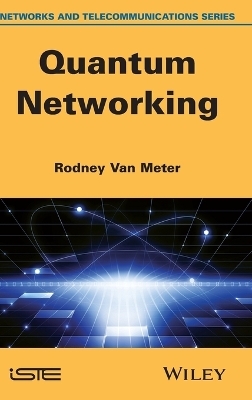
Quantum Networking
ISTE Ltd and John Wiley & Sons Inc (Verlag)
978-1-84821-537-5 (ISBN)
Rodney van Meter is Associate Professor, Faculty of Environment and Information Studies, Keio University, Fujisawa, Japan.
Notations xiii
Acknowledgements xv
Introduction xix
Chapter 1 Overview 1
1.1 Introduction 2
1.2 Quantum information 4
1.3 Quantum repeaters 10
1.4 Network architectures 15
1.5 Conclusions 20
Part 1 Fundamentals 23
Chapter 2 Quantum Background 25
2.1 Introduction 26
2.2 Schrodinger's equation 28
2.3 Qubits 29
2.4 Manipulating qubits 41
2.5 Bell pairs 47
2.6 The no-cloning theorem 53
2.7 Conclusion 54
Chapter 3 Networking Background 55
3.1 Concepts 56
3.2 Challenges in scaling up networks 63
3.3 Design patterns 65
3.4 The Internet 75
3.5 Conclusion 77
Chapter 4 Teleportation 79
4.1 The basic teleportation operation 79
4.2 Experimental demonstration of teleportation 82
4.3 State machines for teleportation 84
4.4 Teleporting gates 86
4.5 Conclusion 88
Part 2 Applications 91
Chapter 5 Quantum Key Distribution 93
5.1 QKD and the purpose of cryptography 94
5.2 BB84: single-photon QKD 97
5.3 E91: entanglement-based protocol 100
5.4 Using QKD 101
5.5 Existing QKD networks 105
5.6 Classical control protocols 109
5.7 Conclusion 111
Chapter 6 Distributed Digital Computation and Communication 113
6.1 Useful distributed quantum states 114
6.2 Coin flipping 118
6.3 Leader election 119
6.4 Quantum secret sharing 121
6.5 Byzantine agreement 126
6.6 Client-server and blind computation 128
6.7 Conclusion 130
Chapter 7 Entangled States as Reference Frames 131
7.1 Qubits in the environment 131
7.2 Distributed clock synchronization 135
7.3 Very long baseline optical interferometry 141
7.4 Conclusion 145
Part 3 Lines of Repeaters 147
Chapter 8 Physical Entanglement and Link-Layer Protocols 149
8.1 Creating entanglement using light 149
8.2 Memory and transceiver gubits 156
8.3 Link structure 161
8.4 State machines and protocol interactions 163
8.5 Managing density matrices in distributed software 164
8.6 Examples 169
8.7 Conclusion 173
Chapter 9 Purification 175
9.1 Measurement revisited 175
9.2 Basic purification 177
9.3 Scheduling purification 185
9.4 State machines and protocol interactions 187
9.5 More complex purification protocols 190
9.6 Experimental demonstrations 192
9.7 Conclusion 193
Chapter 10 Purfication and Entanglement Swapping-Based Repeaters 195
10.1 Hardware architectures 195
10.2 Getting from here to there 197
10.3 Nested purification session architecture 203
10.4 State machines and protocol interactions 206
10.5 Putting it all together 208
10.6 Considerations in the design of a simulator 215
10.7 Conclusion 217
Chapter 11 Quantum Error Correction-Based Repeaters 219
11.1 Quantum error correction 220
11.2 CSS repeaters 223
11.3 Surface code repeaters 230
11.4 Conclusion 235
Chapter 12 Finessing the Key Limitations 237
12.1 Quasi-asynchronous 238
12.2 Memoryless 244
12.3 Summary: comparing quantum communication approaches 247
12.4 Conclusion 251
Part 4 Networks of Repeaters 253
Chapter 13 Resource Management and Multiplexing 255
13.1 Simulated network and traffic 256
13.2 Simulations 259
13.3 Conclusion 263
Chapter 14 Routing 265
14.1 Introduction 265
14.2 Difficulties: differences between quantum and classical networks 267
14.3 Problems and solutions 268
14.4 Simulation and results 270
14.5 Conclusion 283
Chapter 15 Quantum Recursive Network Architecture 285
15.1 Review: network architecture 286
15.2 Recursive quantum requests 288
15.3 Implementing recursion in quantum networks 294
15.4 Example 295
15.5 Conclusion 298
Chapter 16 Coda 301
16.1 Future development 301
16.2 Open problems 303
16.3 Further readings for depth 304
16.4 Further readings for breadth 305
16.5 Final thoughts 307
Bibliograpy 309
Index 331
| Verlagsort | London |
|---|---|
| Sprache | englisch |
| Maße | 163 x 241 mm |
| Gewicht | 689 g |
| Themenwelt | Technik ► Elektrotechnik / Energietechnik |
| Technik ► Nachrichtentechnik | |
| ISBN-10 | 1-84821-537-1 / 1848215371 |
| ISBN-13 | 978-1-84821-537-5 / 9781848215375 |
| Zustand | Neuware |
| Haben Sie eine Frage zum Produkt? |
aus dem Bereich


